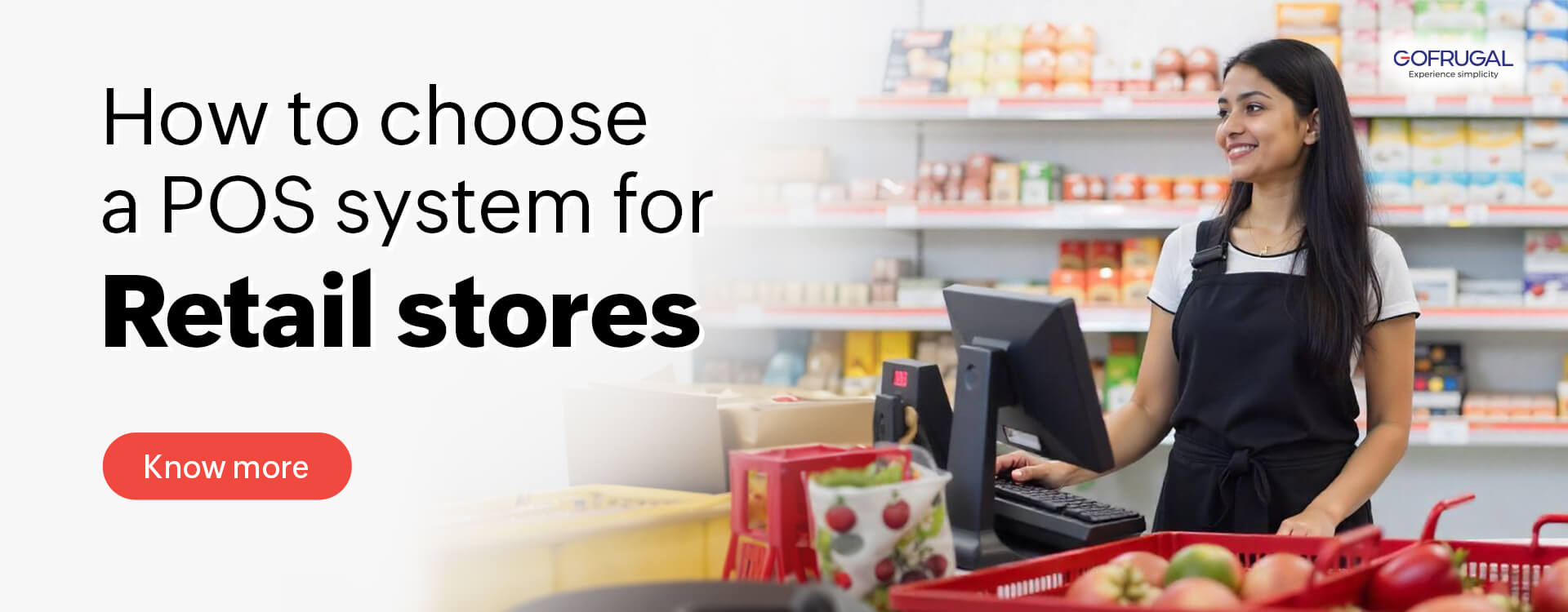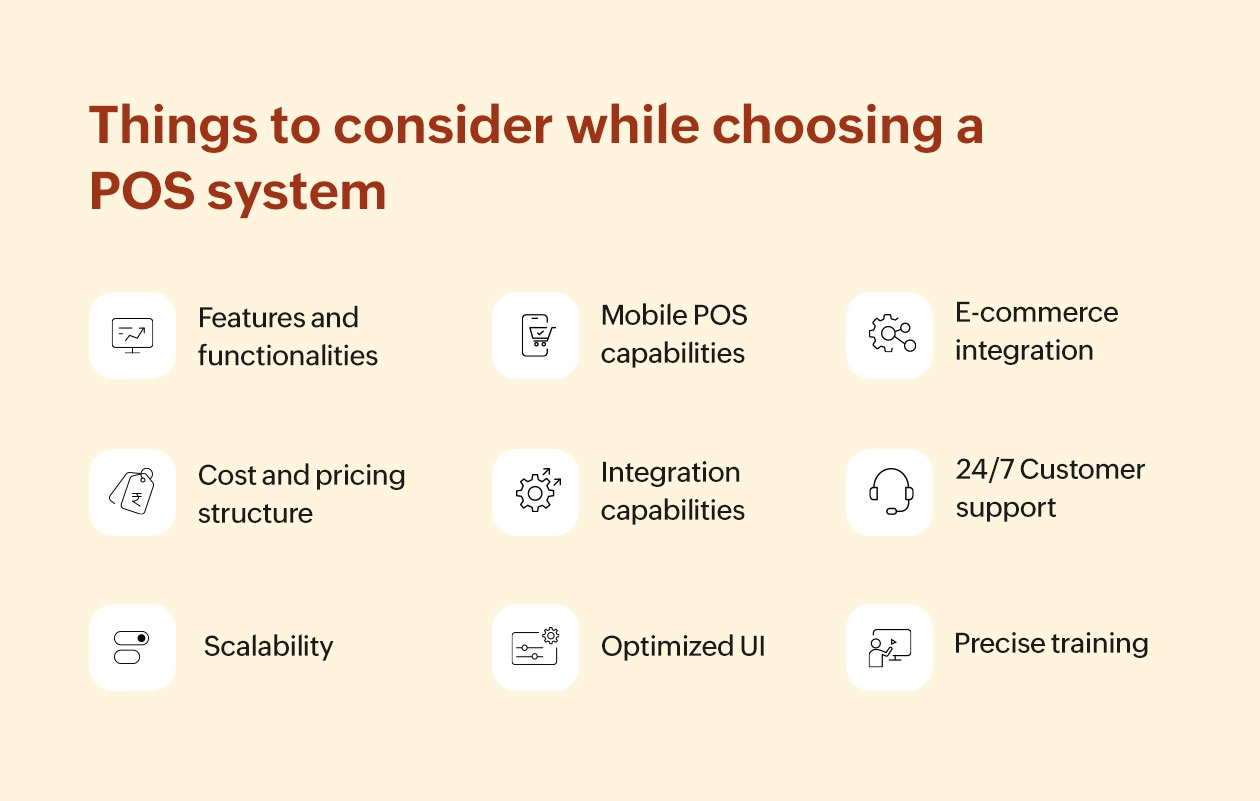Key takeaways:
- Choose a POS system that enhances customer experience, streamlines inventory management, and provides real-time sales data for informed decision-making.
- Evaluate the POS system’s scalability, integration capabilities, and cost structure to support your store's growth and seamless operations.
- Opt for an intuitive, cloud-based POS system like Gofrugal, offering mobile access, real-time tracking, and 24/7 support for efficient store management.
In retail, products usually grab all the attention, but one tool quietly makes a big difference: the POS system. It might not be in the spotlight, but a good POS can boost sales, keep track of stock, and improve customers' shopping experiences. Look at how the right POS system can help your store succeed and stand out and explore how the right POS can elevate your retail business and give you a competitive edge.
Contents
- Importance of choosing the right POS system for retail stores
- 6 things to consider when choosing a POS system
- 10 questions to ask when selecting a POS system
- Challenges of traditional POS systems
- Why should you choose the Gofrugal POS system for your retail store management?
- Customer case study
Importance of choosing the right POS system for retail stores
Picture this: You’re running a busy store, but your staff is constantly searching for products that are out of stock, leading to frustrated customers. Or, you’re stuck at the end of each day trying to make sense of messy, outdated sales reports, unsure of what’s selling and what’s not. This is the reality for many retailers without the right POS system. A modern POS solves these headaches by automating your stock management, alerting you when it’s time to reorder, and offering real-time data on what’s flying off the shelves.
It’s not just about stock—customer experience is another crucial factor. Shoppers today expect fast, personalized service, whether they’re in-store or online. A good POS system for retail stores helps you keep track of customer preferences, making it easier to offer personalized recommendations and loyalty perks. Imagine being able to greet a regular customer by name and offer them a deal on their favourite products right at checkout. That’s the level of service that can set you apart from competitors.
On top of that, you have detailed sales reports at your fingertips—no more guessing games. You’ll know exactly which products are your bestsellers, which days are your busiest, and even which employees are closing the most sales. This kind of insight is essential for making data-driven decisions that grow your business.
6 things to consider when choosing a POS system
1. Features and functionality of a POS system
When choosing a retail POS system, it's important to categorize the features based on their impact on your day-to-day operations and long-term growth. Here's a breakdown of those features.
Essentials for operations
These are the core features that ensure your retail store runs smoothly.
- Sales processing: Efficiently process transactions, handle refunds, and manage multiple payment methods (cash, card, digital wallets, and more).
- Inventory management: Track stock levels in real-time, automate reordering, and prevent stockouts or overstocking.
- Purchase management: Manage vendor orders, track incoming stock, and maintain purchase history for better inventory control.
- Employee management: Monitor staff performance, track working hours, and assign roles or permissions to manage store access.
- CRM (customer relationship management): Store customer information, purchase history, and preferences to personalize service and boost loyalty.
- Reporting and analytics: Generate detailed reports on sales trends, inventory turnover, employee performance, and customer insights to make informed decisions.
Growth drivers
These advanced features help your business scale and adapt to changing retail trends.
- Mobile POS capabilities: Process sales on the go, allowing for flexible customer service and quicker checkouts which are especially useful during peak hours or events.
- Omnichannel retailing: Seamlessly integrate in-store and online sales channels to give customers a unified shopping experience across platforms.
- Payment processing options: Support multiple payment methods, including contactless payments, and mobile wallets to meet modern customer preferences.
- E-commerce integration: Sync your POS with online stores to update inventory and sales data across both platforms in real-time.
- Loyalty program integration: Encourage repeat purchases by offering loyalty rewards and personalized offers based on customer behaviour.
2. Cost and pricing structure
When choosing a retail POS system, it's essential to understand the costs involved.
- Upfront costs: This includes software, hardware, and setup fees.
- Additional charges: Be aware of recurring fees, such as transaction fees, subscription plans, and maintenance costs.
- Return on investment (ROI): While there’s an initial expense, a good POS should save time, reduce errors, and boost sales, providing long-term value.
3. Scalability
Your retail POS system should grow with your business.
- Handling growth: It must efficiently manage higher sales volumes and multiple locations as it expands.
- Flexibility for expansion: Look for features that allow you to add more users, stores, or payment options easily.
4. Integration capabilities
A retail POS system for retail stores must work well with your existing tools.
- Software compatibility: Ensure it integrates seamlessly with other systems like accounting software, e-commerce platforms, and CRMs for smoother operations.
5. Ease of use and user interface
The system should be simple for you and your staff to use.
- Intuitive design: A user-friendly layout ensures quick adoption and smooth operation.
- Minimal training: Look for a system that requires little training so your team can hit the ground running.
6. Customer support and training
Reliable support can decrease downtime.
- Technical support: Ensure you have access to around-the-clock assistance for troubleshooting.
- Training resources: Look for helpful tutorials, guides, and responsive customer service to get the most out of your POS system.
10 questions to ask when selecting a POS system
- What are the daily transaction volumes I handle, and can the POS system support this efficiently?
Choose a retail POS system that can handle high transaction volumes without slowing down to ensure smooth performance during peak hours. - Does the POS system offer both in-store and online sales integration?
Choose a POS system for retail stores that integrates both channels seamlessly, keeping an inventory, sales, and customer data synchronized in real time. - Is the system user-friendly, and how much training will my staff need to operate it?
Opt for a retail POS system with an intuitive interface that requires minimal training, helping your staff adapt quickly and get started faster. - Can the POS system scale as my business grows, adding new locations or higher sales volume?
Ensure the POS system can easily scale with your business, accommodating new locations, higher transaction volumes, and expanding operations. - Does the system offer robust inventory management with real-time tracking and automatic reordering?
A POS with real-time inventory tracking and automated reordering helps you maintain optimal stock levels and prevent stockouts. - How important is data security and compliance?
Prioritize a POS system that meets current data security standards, ensuring customer and business data are protected against breaches. - Can the POS system integrate with my existing software, such as accounting, CRM, or e-commerce platforms?
Look for a POS that seamlessly integrates with your existing tools—like accounting, CRM, and e-commerce platforms—reducing manual data entry and improving efficiency. - What kind of customer support and technical assistance is available, and is it 24/7?
Choose a POS system for retail stores with reliable 24/7 customer support to quickly resolve technical issues and minimize operational downtime. - Does the POS system provide detailed analytics and reporting to help me make informed business decisions?
A system with comprehensive reporting and analytics will provide valuable insights into sales trends, inventory performance, and customer behaviour to drive smarter decisions. - What is the total cost of ownership, including setup, ongoing fees, and potential upgrades?
Consider the upfront costs, monthly fees, and upgrade flexibility to ensure the POS system offers long-term value with transparent pricing.
Challenges of traditional POS systems
Lack of mobility
Traditional POS systems are fixed at a single point, limiting flexibility. Staff can’t move around to assist customers on the floor or handle remote sales, slowing down service. When you choose a POS system for retail stores, ensure it offers mobile capabilities to support on-the-go sales.
Poor integration
Integrating traditional POS systems with today’s ecommerce platforms, CRMs, and accounting tools is challenging, leading to disconnected systems and manual data entry. To avoid this, choose a retail POS system that integrates seamlessly with these essential tools.
Limited scalability
Scaling with traditional POS systems requires significant hardware investments and manual updates which can limit growth potential. As you evaluate how to choose a POS system for retail stores, look for one that scales effortlessly with your business needs.
Manual inventory management
Older POS systems need manual updates for inventory tracking, often resulting in errors, inefficiency, and stockouts. Choosing a retail POS system with real-time inventory tracking helps maintain stock accuracy and streamline restocking.
Data security risks
Traditional POS systems may lack the data security needed today, exposing sensitive information to breaches or fraud. When you choose a retail POS system, prioritize one that offers advanced security measures to protect customer data.
Lack of advanced reporting and analytics
Traditional systems often lack detailed reporting or analytics, making it difficult to analyze sales trends or customer behaviour. When you choose a POS system for your retail store, opt for one with robust reporting to support data-driven decisions.
Why should you choose the Gofrugal POS system for your retail store management?
Gofrugal POS provides an all-in-one solution, making it a smart choice for a retail POS system that will support growth, efficiency, and exceptional service.
- Ease of use: Gofrugal’s intuitive interface and customization make it easy to set up and tailor it to your store, making it an ideal choice when you’re looking to choose a retail POS system.
- Inventory control: With real-time tracking, automated reordering, and alerts, Gofrugal helps you keep inventory at optimal levels.
- Seamless integrations: Gofrugal integrates with ecommerce, CRM, and accounting platforms, offering a unified solution for your retail operations.
- Affordable and scalable: With flexible pricing and scalability, Gofrugal grows with your business, supporting expansion effortlessly.
- Cloud and mobile-friendly: As a cloud-based, mobile-compatible system, Gofrugal allows remote access and on-the-go sales capabilities.
- 24/7 support: Around-the-clock assistance and extensive training resources ensure smooth, uninterrupted operations.
A multi-outlet retail store optimizes billing and inventory seamlessly with Gofrugal
One of our long-term customers scaled from e-commerce to a thriving multistore chain with Gofrugal! They share how Gofrugal simplified inventory management, sales tracking, and GST compliance for their pooja shopping business.
Investing in the right POS system is one of the smartest moves you can make for your retail store’s future. The right system does more than process payments—it improves customer satisfaction, streamlines daily operations, and positions your store for sustainable growth. By keeping your business's needs in mind and asking the right questions, you’ll know how to choose a POS system for retail stores that fits your requirements today and adapts with you tomorrow.



